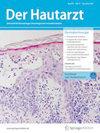施尼茨勒综合征
4区 医学
Q3 Medicine
引用次数: 0
摘要
施尼茨勒综合征是一种非常罕见的获得性系统疾病,与遗传性自身炎症综合征有许多相似之处。其主要特征是全身性红斑和 IgM 单克隆抗体阳性。其他临床特征包括发热、肌肉、骨骼和/或关节疼痛以及淋巴结病。约 15-20% 的施尼茨勒综合征患者会发展为淋巴组织增生性疾病,在极少数情况下,如果不进行治疗,可能会发生淀粉样蛋白 A(AA)淀粉样变性。先天性免疫系统的激活,尤其是白细胞介素(IL)-1β,是疾病发病机制的核心。因此,通过使用IL-1受体拮抗剂anakinra治疗,80%的患者可以完全控制疾病症状。本文章由计算机程序翻译,如有差异,请以英文原文为准。
Schnitzler syndrome.
Schnitzler syndrome is a very rare acquired systemic disease with many similarities to hereditary autoinflammatory syndromes. The main characteristics are generalized exanthema and IgM monoclonal gammopathy. Other clinical features include fever, muscle, bone, and/or joint pain, and lymphadenopathy. About 15-20% of patients with Schnitzler syndrome develop lymphoproliferative diseases and, in rare cases, amyloid A (AA) amyloidosis can occur if the disease is not treated. Activation of the innate immune system, especially interleukin (IL)-1β, is central to the pathogenesis of disease. Consequently, complete control of disease symptoms can be achieved in 80% of patients by treatment with the IL-1 receptor antagonist anakinra.
求助全文
通过发布文献求助,成功后即可免费获取论文全文。
去求助
来源期刊

Hautarzt
医学-皮肤病学
CiteScore
1.40
自引率
0.00%
发文量
93
审稿时长
4-8 weeks
期刊介绍:
Der Hautarzt is an internationally recognized journal informing all dermatologists working in practical or clinical environments about important developments in the field of dermatology including allergology, venereology and related areas.
Comprehensive reviews on a specific topical issue focus on providing evidenced based information on diagnostics and therapy.
Freely submitted original papers allow the presentation of important clinical studies and serve the scientific exchange.
Case reports feature interesting cases and aim at optimizing diagnostic and therapeutic strategies.
Review articles under the rubric "Continuing Medical Education" present verified results of scientific research and their integration into daily practice.
 求助内容:
求助内容: 应助结果提醒方式:
应助结果提醒方式:


